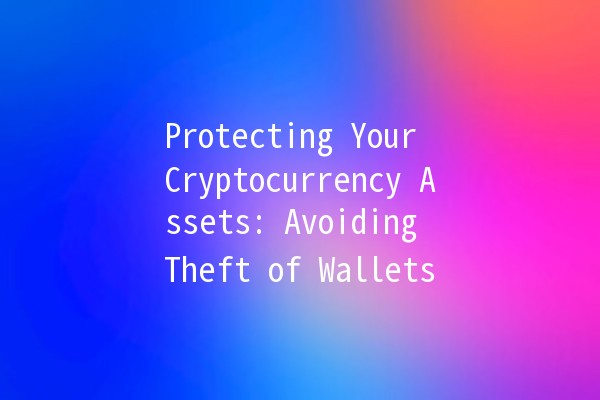
In today's digital era, cryptocurrencies have gained immense popularity, but with this growth comes increased risks. The threat of theft is one of the most significant concerns for cryptocurrency users, leading to the need for robust security measures to protect their digital assets. In this article, we'll explore practical tips and tricks to ensure that your cryptocurrency wallet remains secure and your assets protected from theft.
What is a Hardware Wallet?
A hardware wallet is a physical device designed to securely store your cryptocurrency private keys offline. This provides an extra layer of security as it is less susceptible to online hacking attempts.
How to Use:
Choose a Reputable Hardware Wallet: Research hardware wallets and select one with a strong reputation for security. Some popular options include Ledger and Trezor.
Set Up the Wallet Properly: Follow the manufacturer’s instructions to set up your wallet. Ensure that your recovery seed phrase is written down securely and kept offline.

Keep the Wallet Offline: Only connect your hardware wallet to the internet when necessary. This minimizes exposure to potential hacks.
Example Application:
When you need to make a transaction, connect your hardware wallet to your computer, sign the transaction using the device, and then disconnect it immediately after the transaction is complete. By keeping the wallet offline when not in use, you significantly decrease the chances of theft.
Understanding 2FA
Twofactor authentication adds an additional layer of security by requiring not just a password but also a second form of verification—usually a code sent to your mobile device.
How to Implement:
Choose a Trusted 2FA App: Use a reputable app like Google Authenticator or Authy for generating 2FA codes.
Enable 2FA on All Accounts: Activate 2FA on your cryptocurrency exchange accounts, wallets, and any related services.
Backup 2FA Codes: Store backup codes securely, as they can help you recover access if you lose your device.
Example Application:
Whenever you log in to your cryptocurrency exchange, after entering your password, you will be prompted to enter a code generated by your 2FA app. This added step ensures that even if someone obtains your password, they cannot access your account without the second form of verification.
The Importance of Updates
Cryptocurrency software, including wallets and exchanges, frequently release updates to patch security vulnerabilities. Keeping software up to date is crucial in maintaining security.
Action Steps:
Enable Automatic Updates: If available, enable automatic updates for your wallets and software to ensure you receive the latest security patches.
Check for Updates Manually: Regularly check the official websites or app stores for updates if automatic updates are not an option.
Stay Informed About Security Practices: Follow relevant blogs and news platforms to stay updated on the latest security tips.
Example Application:
Set a recurring reminder on your calendar every month to review and update your wallet software. Ensuring your wallet is on the latest version helps protect against newly discovered vulnerabilities.
Crafting a Secure Password
A strong password is vital to protecting your cryptocurrency accounts and wallets from unauthorized access.
Password Safety Tips:
Create Long and Complex Passwords: Use a mix of upper and lowercase letters, numbers, and special characters. A password manager can help you generate and manage complex passwords.
Avoid Reusing Passwords: Utilizing the same password across multiple accounts increases risk. Use unique passwords for different accounts.
Change Passwords Regularly: Set a schedule (e.g., every three to six months) to change your passwords, especially for your most critical accounts.
Example Application:
Use a password manager like LastPass or 1Password to generate and store your passwords securely. This not only keeps your passwords complex and varied but also makes it easier to manage them across multiple accounts.
Identify Phishing Threats
Phishing attacks often come in the form of deceptive emails or websites designed to trick you into revealing personal information or login credentials.
Protection Measures:
Check URLs Carefully: Always verify the URL of any website before entering your login details. Look for secure connections (https) and official branding.
Be Cautious with Emails: Never click on links within emails claiming to be from cryptocurrency platforms. Instead, visit the official site directly through your browser.
Educate Yourself: Familiarize yourself with common phishing tactics to recognize them quickly.
Example Application:
If you receive an email alerting you about unusual activity in your account, instead of clicking the link provided, manually type the website's URL into your browser to verify any issues directly.
Frequently Asked Questions
If you believe your wallet has been compromised, immediately transfer your assets to a new wallet. Change passwords and enable 2FA on your accounts. Notify any platforms involved and monitor accounts closely for unauthorized activity.
If you lose access to your hardware wallet, recovery is possible if you have securely stored your recovery seed phrase. Use this phrase to restore your wallet on a new device to regain access to your assets.
While all cryptocurrencies can be targets for theft, those that operate on less secure platforms or have weak development teams may be more susceptible. Always conduct research and select projects with strong security measures in place.
Yes, using multiple wallets is a common security measure. You can split your holdings across a hardware wallet, a mobile wallet, and an exchange wallet to reduce risk. This way, even if one wallet is compromised, your other assets remain secure.
Social engineering involves manipulating individuals to gain confidential information. Be wary of unsolicited communications asking for personal data or funds. Always verify requests through trusted channels.
While leaving assets on exchanges may be convenient, it poses a greater risk of theft. It's generally safer to withdraw your assets to a secure wallet you control, especially for longterm holding.
In an increasingly digital world, ensuring the safety of your cryptocurrency assets is critical. By implementing these tips, you can significantly reduce the risk of theft and protect your hardearned investments. Stay vigilant, stay informed, and keep your assets secure!

